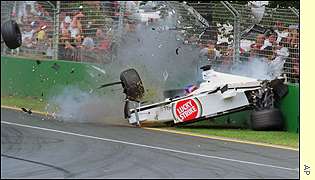
|
|
||||
 |
| You are in: Motorsport: Formula One |

|
F1's pressing safety question
 Jacques Villeneuve's BAR disintergrates on impact
By BBC Sport Online's Charlie Henderson
Formula One re-invented itself in terms of safety after the third Grand Prix of the 1994 season. The sport was left reeling by two deaths - its biggest name, Brazil's Ayrton Senna, and his fellow driver Roland Ratzenberger - at the Imola Grand Prix. Seven years on, the cars on show at the Australian Grand Prix were testament to the changes in the sport. Michael Schumacher, Luciano Burti and Jacques Villeneuve all walked away from spectacular crashes.
But Formula One, the fastest and most glamorous sport in the world, is yet again stained by the stigma of death after a marshal died from injuries sustained at the track-side following Villeneuve's collision with Ralf Schumacher. The death of Graham Beveridge, a 52-year-old volunteer from Queensland, is the second of its type in five races. At Monza in the 2000 season another track marshal, Paolo Ghislimberti, died when he, like Beveridge, was hit by flying debris following a six-car pile-up. Ghislimberti was the first fatality at a Formula One circuit since the death of Senna. But the sport has seemingly failed to respond to the need to protect those who officiate and watch events as it has to the need to protect its own drivers. Besides Beveridge a further seven spectators were injured at the Whiteford turn on the Albert Park circuit. Technical development Drivers remain the focus of regulation changes that the sport imposes upon itself. The latest technical alterations have focused on implementing a reduction in speed through aerodynamic changes and the imposition of strict safety tests on all cars.
However in Melbourne Ferrari's Michael Schumacher recorded a fastest lap that was over three seconds quicker than the one his team-mate Rubens Barrichello set the year before. The introduction of Michelin tyres, breaking the monopoly that Bridgestone had on the sport, has increased competition in the development of tyres that has totally off-set changes in aerodynamics. Changes in the cockpit set-up and increased load testing on the area around the driver help to ensure the safety of the sports front line stars despite increasing speeds. However at the first race of the season, as those changes can be applauded following the sight of three drivers climbing from tangled wreckages, a third major change has had little impact. Repeated tragedy Following the double tragedy of Imola 1994 cars were immediately limited to a capacity of three litres in an attempt to save the sport from further fatalities. After Monza 2000 FIA imposed a new regulation in an attempt to prevent wheels becoming separated from cars in the event of an accident. Two cables, threaded through the suspension arms and designed to withstand a force of 10 tonnes, now attach the wheel to the body of the car as opposed to one. However at the first active test in the new season the changes have proved insufficient and the sport is now reeling from a second double tragedy. Need for change Each team spends £1m for each of their cars and the BAR, like all other teams, has been improved over the close season.
No stone remains unturned in the search for improving the efficiency and performance of a Formula One car. But at the expense of car improvement the safety of the event's unpaid volunteers remains under-funded. "There are things that have been done since last year. "The extra security on the wheels for instance - but the impact (of Villeneuve's crash) was so severe it is difficult to know what you could do," admitted Ross Brawn, Ferrari's technical director. Patrick Head, technical director of Williams, counters: "Perhaps now the thing to do is to try and protect the marshals better rather than concentrate on the cars." The sport clearly needs to find quick answers to searching questions as it looks to re-invent itself in terms of safety for a second time after another double tragedy.
|
See also:
Other top Formula One stories:
Links to top Formula One stories are at the foot of the page.
|
||||||||||||||||||||||||||||
|
Links to other Formula One stories
|
| ^^ Back to top | ||
| Front Page | Football | Cricket | Rugby Union | Rugby League | Tennis | Golf | Motorsport | Boxing | Athletics | Other Sports | Sports Talk | In Depth | Photo Galleries | Audio/Video | TV & Radio | BBC Pundits | Question of Sport | Funny Old Game ------------------------------------------------------------ BBC News >> | BBC Weather >> ---------------------------------------------------------------------------------- © MMII | News Sources | Privacy |
||